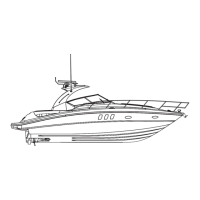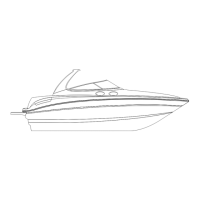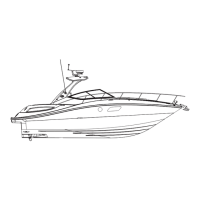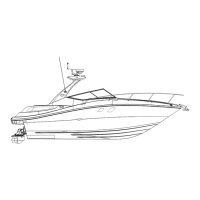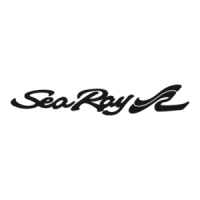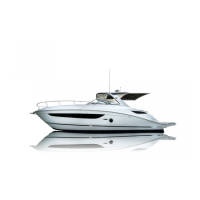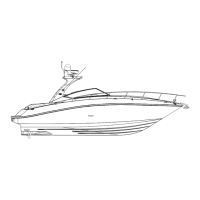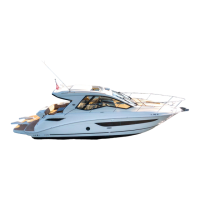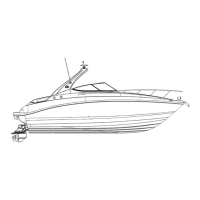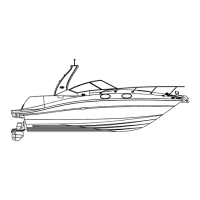Do you have a question about the Sea Ray 320 Sundancer and is the answer not in the manual?
Explains the manual's content, including safety, features, and maintenance.
Outlines operator duties for safe boating, navigation, and regulatory compliance.
Lists resources for boating courses and safety information.
Details the dealer's role in boat delivery, demonstration, and customer orientation.
Covers express limited warranty for structural defects and parts, including exclusions.
Explains the importance of the HIN for correspondence and orders.
Details CE and NMMA certifications and required manufacturer information.
Provides contact information for service, parts, and repair needs.
Summarizes the Sea Ray limited warranty, its coverage, and limitations.
Explains the meaning and importance of safety labels throughout the manual and boat.
Lists minimum safety equipment required by the U.S. Coast Guard for boats.
Details the automatic and portable fire extinguisher systems and their operation.
Covers CO hazards, symptoms, prevention, and the function of CO monitors.
Describes requirements and types of Personal Flotation Devices (PFDs) and throwable devices.
Lists recommended safety gear beyond legally mandated equipment for offshore boating.
Warns against operating a boat under the influence of drugs or alcohol.
Explains how to interpret the certification plate for maximum weight and passenger limits.
Advises against exceeding the maximum engine power rating for the vessel.
Discusses propeller selection, pitch, and maintenance for optimal performance.
Details factors affecting boat stability and the risks of exceeding load capacities.
Emphasizes situational awareness, speed adjustment, and passenger safety.
Explains boat design categories and provides rules for operating in various weather conditions.
Stresses the importance of charting courses and using navigational aids to avoid hazards.
Provides safety guidelines for swimming, skiing, and diving activities.
Offers guidance on responding to medical emergencies, water rescues, fires, and collisions.
Lists contact information for U.S. Coast Guard and Canadian Coast Guard safety hotlines.
Lists international standards and authorities for vessel construction.
Defines common nautical terms used in the manual and boating.
Explains symbols used on controls and in diagrams for easy identification.
Provides key dimensions and clearance specifications for the boat.
Illustrates the arrangement of deck components and features for easy identification.
Details the layout and function of gauges and switches at the helm station.
Identifies and explains the purpose of various through-hull fittings on the boat.
Explains the operation of key controls like gear shift, throttle, and trim tabs.
Describes the function of essential gauges like tachometers, oil pressure, and water temperature.
Explains the operation and requirements for navigation and anchor lights.
Provides critical pre-use, launch, and post-trip checks for safe operation.
Details safe procedures for fueling the boat, including precautions and tank filling.
Offers guidelines for safe boarding, preventing overload, and transferring gear.
Emphasizes the importance of PFDs and proper usage for all passengers.
Covers instructing passengers on boat behavior and safe seating during operation.
Provides essential pre-start checks and procedures for safely starting the boat's engines.
Explains how to shift into gear and control the boat's movement.
Details the correct procedure for shutting down the engines to prevent damage.
Describes the standard steering system, its maintenance, and warnings.
Explains the hydraulic steering system used with optional V-drive engines.
Covers the operation, safety, and maintenance of the boat's windlass system.
Discusses bilge area, fuel/oil spillage, electric hatches, and drain plugs.
Covers engine operation, maintenance, and specific warnings for stern drives.
Explains the adjustable engine mounts and the importance of proper tightening.
Details the function of reduction and reverse gears, including maintenance.
Describes the underwater exhaust system and its components.
Provides a generalized procedure for engine removal and reinstallation.
Identifies common causes of boat vibration and when to seek professional help.
Explains the fresh water cooling system and coolant recommendations.
Covers propeller characteristics, cavitation, and ventilation.
Explains the rudder's function and the rudder stuffing box's role in preventing leaks.
Details the function of seacocks and strainers for cooling systems and maintenance.
Provides a diagram showing the location of bilge components for standard engines.
Illustrates the bilge layout for boats equipped with optional V-drive engines.
Describes the standard gasoline fuel system, tank capacity, and vents.
Explains how to drain water and replace fuel filter elements in diesel systems.
Details essential safety precautions for fueling, including checklists and spill prevention.
Covers the 12-volt DC system, batteries, charging, and maintenance.
Emphasizes using ignition-protected components in gasoline environments to prevent sparks.
Advises on replacing fuses and breakers with the correct amperage rating.
Explains the location and function of the main DC breaker panel and its breakers.
Details the controls and functions of the cabin DC breaker panel for various systems.
Describes the electronic switch pads and their connection to Electronic Interface Modules (EIMs).
Explains how to use the emergency start system to parallel batteries for starting.
Identifies the location of 12-volt accessory outlets for powering devices.
Provides guidance on replacing interior and exterior lighting bulbs.
Covers 120V/60Hz and 220V/50Hz AC wiring, shore power connection, and safety.
Details procedures for connecting and disconnecting shore power safely.
Explains the controls and functions of the cabin AC distribution panel.
Describes the automatic battery charger/converter and its charging characteristics.
Explains the purpose and location of GFI receptacles for shock hazard protection.
Covers generator operation, starting, stopping, and maintenance recommendations.
Explains how to minimize electrolytic corrosion using zinc anodes and galvanic isolators.
Details the Mercathode® system for protecting underwater metals from corrosion.
Refers to subsections for electrical schematics and wiring harness illustrations.
Provides diagrams illustrating wire harness installation for various systems.
Refers to detailed electrical schematics for specific boat configurations.
Directs users to diagrams showing the location of boat features and components.
Explains the operation, maintenance, and starting procedure for the A/C and heating system.
Covers the fresh water system, operation, sanitizing, and winterizing procedures.
Describes the gray water system for boats in restricted discharge areas.
Details various head system options, operator requirements, and cautions.
Discusses TV signal selectors, cable connections, and 12-volt stereo systems.
Explains the setup and operation of the optional telephone system.
Covers the operation and indicators for gasoline and diesel engine automatic fire extinguishers.
Explains the operation of the refrigerator/freezer on both 12V DC and AC power systems.
Describes the power ventilation system for removing air and odors from the head and galley.
Details the operation and maintenance of the drip coffee maker.
Explains the operation of the electric stove and its safety features.
Covers the operation of the microwave oven.
Discusses canvas installation, care, and safety warnings related to carbon monoxide.
Explains how to operate the electric windshield vent.
Describes the operation of the electric horn.
Details how to operate the optional spotlight.
Explains the function and components of the optional bow thruster.
Provides instructions for converting the aft seating area into a bed.
Details the steps to convert the salon sofa into a bed.
Explains the operation and location of the central vacuum system components.
Provides a chart summarizing inspection and maintenance activities with recommended intervals.
Offers a log for recording essential boat and engine service information.
Details specific inspection procedures for the bilge area, engine, and fuel system.
Advises on inspecting wiring for support, insulation, terminals, and connections.
Guides on checking bilge fittings, hoses, clamps, and fasteners for damage or wear.
Provides advice on securing the boat, including removing keys and stowing gear.
Explains the procedure for lubricating seacocks to ensure proper operation.
Offers a checklist for pre-departure checks, engine startup, and securing the boat.
Provides space to list and check the condition of any added safety or operational equipment.
Offers a logbook to record all maintenance performed on the boat.
Warns against using harmful cleaning agents and advises on proper product selection.
Covers cleaning and waxing gelcoat surfaces to maintain luster and protect the fiberglass.
Provides methods for removing stains and minor scratches from gelcoat and painted surfaces.
Discusses methods for preventing marine growth on boat bottoms.
Explains how to clean and maintain bottom paint, and when to consult a dealer.
Guides on cleaning stainless steel and alloy fittings, and protecting them.
Advises on simple cleaning methods for gauge and switch panels.
Provides instructions for cleaning acrylic plastic windows and removing scratches.
Covers cleaning, drying, and storing canvas and clear vinyl to prevent damage.
Details cleaning and maintenance for exterior upholstery fabrics.
Refers to manufacturer information for cleaning and maintaining interior upholstery.
| Deadrise | 21° |
|---|---|
| Sleeping Capacity | 6 |
| Water Capacity | 32 gallons |
| Holding Tank Capacity | 28 gallons |
| Engine Options | Twin MerCruiser 6.2L MPI |
